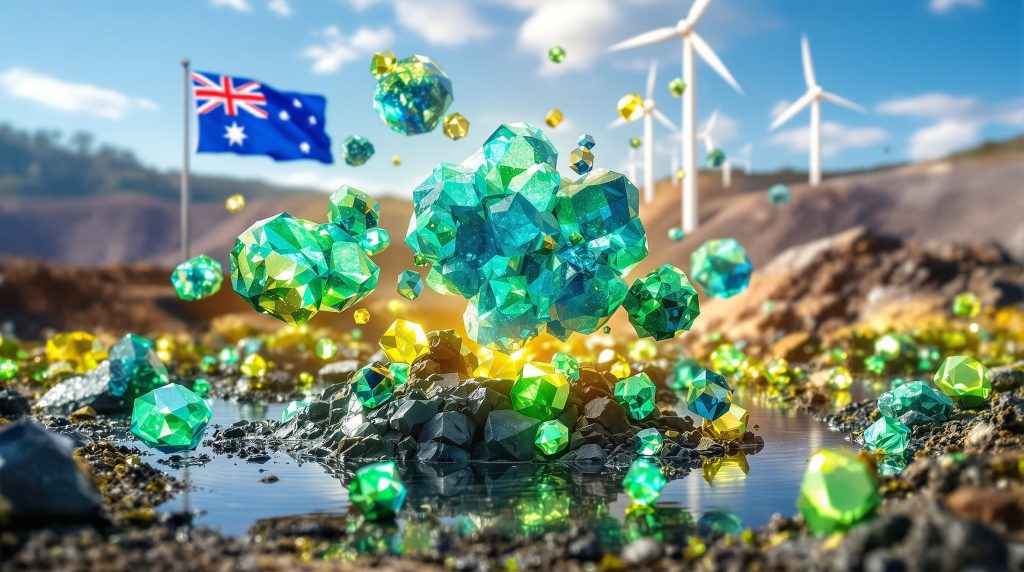Tasmania's Rare Earth Discovery: Unlocking Critical Minerals for the Future
The Deep Leads rare earth project in Tasmania represents a significant breakthrough in Australia's critical minerals landscape. Recent testing by the Australian Nuclear Science and Technology Organisation (ANSTO) has confirmed the deposit's exceptional commercial potential, particularly for heavy rare earth elements that are crucial for advanced technologies.
The clay-hosted rare earth deposit discovered in Tasmania has been validated as a commercial-level rare earths deposit in Tasmania through rigorous testing, positioning Australia to play a more significant role in global rare earth supply chains that have long been dominated by a single country.
Key Findings from ANSTO Testing
Testing conducted by ANSTO on a 100kg bulk sample from the Deep Leads project yielded remarkable results, with extraction rates exceeding 70% for both dysprosium and terbium – two of the most valuable heavy rare earth elements in today's market.
The tests confirmed effective leaching is possible at pH levels above 4.0 (specifically at 4.0, 4.5, and 4.7), which significantly reduces contamination risk from impurity elements such as aluminum and iron.
Perhaps most importantly, the testing validated that the Deep Leads deposit contains the highest ionic proportion of any clay-hosted rare earth resource in Australia, confirming earlier in-house leach test findings by ABx Group.
Strategic Value of the Tasmanian Resource
What makes the Deep Leads deposit particularly valuable is its unusually high concentration of heavy rare earth elements, particularly dysprosium and terbium. These elements command premium prices in global markets, often reaching several hundred dollars per kilogram, compared to lighter rare earths that may sell for tens of dollars per kilogram.
The strategic importance of these elements stems from their irreplaceable role in manufacturing permanent magnets that maintain their magnetic properties at high temperatures – a critical requirement for electric vehicle motors, wind turbine generators, and defense applications.
How Does Tasmania's Rare Earth Profile Compare to Other Deposits?
Australia hosts several rare earth deposits, but the Tasmanian Deep Leads project stands apart due to its unique mineralogical characteristics and processing advantages.
Unique Mineralogical Characteristics
Unlike many Australian rare earth resources that are found in hard rock formations requiring extensive processing, the Deep Leads deposit is clay-hosted. This distinction is critical from both economic and environmental leaching benefits perspectives.
Clay-hosted deposits contain rare earth elements that are ionically bonded to clay minerals, allowing for potentially simpler extraction using leaching methods rather than energy-intensive crushing and complex chemical processing required for hard-rock deposits.
Comparative Advantages
| Feature | Deep Leads (Tasmania) | Typical Hard-Rock REE Deposits | Benefit |
|---|---|---|---|
| Extraction method | Leaching at pH >4.0 | Complex crushing and processing | Lower operating costs |
| Heavy REE content | High proportion of Dy and Tb | Often lower HREE percentages | Higher value product mix |
| Processing complexity | Reduced impurities | Higher contamination risk | Cleaner process, less waste |
| Depth | Near-surface mineralization | Often requires deeper mining | Lower extraction costs |
Environmental Considerations
The ability to process the Deep Leads material at higher pH levels (above 4.0) represents a significant environmental advantage. This reduces the potential for acid contamination and minimizes the extraction of impurity elements such as aluminum and iron, resulting in:
- Lower neutralization requirements
- Reduced waste management challenges
- Smaller environmental footprint
- Potentially faster regulatory approvals
This environmental profile could prove particularly advantageous in Australia's increasingly stringent regulatory environment, where mining projects face growing scrutiny regarding their ecological impact.
What Are the Commercial Applications of Tasmania's Rare Earths?
The rare earth elements found in the Tasmanian deposit serve as critical components in numerous high-tech applications and green energy technologies, making them strategically vital in the global transition toward sustainable energy systems.
Critical Technology Applications
Dysprosium and terbium, which are present in commercially significant quantities in the Deep Leads deposit, play essential roles in several key technologies:
-
Permanent Magnets: These elements enhance the temperature resistance of neodymium magnets, making them suitable for high-performance applications in electric vehicle motors and wind turbine generators.
-
Defense Technologies: Precision-guided weapons, radar systems, and other military equipment rely on the unique properties of heavy rare earths.
-
Electronics: Smartphones, hard drives, and other consumer electronics incorporate small amounts of rare earths in components that require precise magnetic properties.
-
Medical Equipment: MRI machines and specialized medical devices utilize rare earth magnets for their exceptional strength-to-weight ratio.
-
Laser Technologies: Advanced manufacturing processes and research applications employ rare earths in specialized laser systems.
Supply Chain Significance
The development of the Tasmanian rare earth resource could help address a critical vulnerability in global technology supply chains. Currently, China dominates rare earth production, accounting for approximately 70% of global mining output and over 85% of processing capacity.
The Deep Leads project offers several strategic benefits to supply chain security:
- Reduces dependence on a single geographic source
- Strengthens Australia's position in critical minerals markets
- Provides supply security for Western manufacturers
- Creates opportunities for domestic value-adding industries
As technology manufacturers increasingly seek supply chain diversification, particularly for components deemed critical to national security, resources like the Tasmanian deposit gain strategic importance beyond their pure economic value.
What Is the Development Timeline for Tasmania's Rare Earth Project?
The path from discovery to commercial production involves several stages, with ABx Group making steady progress toward developing this valuable resource.
Current Progress
ABx Group has completed several crucial milestones in advancing the Deep Leads project:
- Completed bulk sample testing with ANSTO using a 100kg sample
- Validated extraction methodologies showing high recovery rates
- Confirmed the deposit's high ionic proportion
- Established baseline processing parameters for future development
These achievements provide the technical foundation necessary for advancing toward commercial development.
Next Development Phases
According to company announcements, the project is advancing rapidly with several key milestones anticipated:
- Production of first mixed rare earth carbonate sample expected later in 2025
- Ongoing resource definition drilling to expand the known deposit
- Process optimization studies to maximize recovery rates
- Preliminary economic assessment to quantify commercial potential
- Environmental and regulatory approval processes
The progression from current testing to commercial production will require continued investment and technical development, but the initial results provide promising indicators for economic viability.
Commercialization Strategy
ABx Group is positioning the project for commercial outcomes through a strategic approach that leverages the deposit's unique characteristics:
- Focus on high-value heavy rare earth elements
- Optimization of processing methods to minimize costs
- Exploration of potential partnerships with end-users
- Investigation of value-adding opportunities within Australia
The company's emphasis on producing a mixed rare earth carbonate as an initial product represents a common first step in rare earth development, creating a saleable intermediate product while allowing for potential future expansion into separation and refining.
How Does Tasmania's Rare Earth Discovery Impact Australia's Critical Minerals Strategy?
Australia has identified critical minerals as a strategic priority, with rare earths featuring prominently in national policy discussions about economic security and manufacturing capability.
Strategic National Importance
The Tasmanian rare earth discovery aligns perfectly with Australia's broader critical minerals strategy by:
- Diversifying Australia's mining portfolio beyond traditional commodities like iron ore and coal
- Strengthening domestic supply chains for advanced manufacturing
- Creating opportunities for value-adding downstream processing
- Positioning Australia as a reliable supplier to allied nations
This alignment with national priorities may create opportunities for development support through initiatives designed to enhance critical minerals reserve.
Economic Benefits
Development of the Deep Leads deposit could generate significant economic benefits at local and national levels:
- Creation of skilled jobs in mining and processing
- Development of technical expertise in rare earth extraction
- Potential for downstream manufacturing opportunities
- Export revenue from high-value mineral products
While rare earth operations are typically smaller in scale than traditional mining operations, they often create higher value per tonne of material processed, potentially delivering substantial economic returns.
Global Market Positioning
The unique characteristics of the Tasmanian deposit could help position Australia more prominently in global rare earth markets as:
- Provider of high-purity heavy rare earth elements
- Reliable supplier outside existing dominant supply chains
- Source of ethically and environmentally responsible materials
- Partner in developing critical technology supply chains
This positioning aligns with growing demand from technology manufacturers for responsibly sourced materials with transparent supply chains.
What Challenges Must Be Overcome for Commercial Development?
Despite the promising initial results, several significant challenges remain before the Deep Leads project can achieve commercial production.
Technical Considerations
The path from successful laboratory testing to commercial production involves addressing numerous technical challenges:
- Optimizing extraction processes for maximum recovery
- Scaling up from laboratory to commercial production
- Managing variability across the deposit
- Developing cost-effective separation technologies
While ANSTO's testing provides confidence in the basic extraction approach, translating these results to commercial scale will require significant engineering development.
Market Factors
The commercial success of the project will depend on several market factors that will evolve over the development timeline:
- Future pricing trends for heavy rare earth elements
- Competition from other emerging sources
- Demand growth from technology sectors
- Government policies affecting critical minerals
Price volatility has historically been a challenge in rare earth markets, creating uncertainty for project development. However, the focus on heavy rare earths, which tend to maintain higher price points, may mitigate some of this risk.
Infrastructure Requirements
Developing a commercial rare earth operation will require significant infrastructure investment:
- Processing facilities capable of handling clay-hosted materials
- Water management systems for leaching operations
- Transportation links for moving products to market
- Power supply for processing operations
The relatively accessible location in Tasmania may provide advantages in infrastructure development compared to more remote rare earth resources.
FAQ: Tasmania's Rare Earth Discovery
What makes dysprosium and terbium so valuable?
Dysprosium and terbium are among the most valuable rare earth elements due to their essential role in creating high-performance permanent magnets that maintain their magnetic properties at high temperatures. These magnets are critical components in electric vehicle motors, wind turbine generators, and numerous defense applications. Global supply of these elements is limited, with China currently dominating production.
The value of these elements stems from their scarcity and technical irreplaceability—no suitable substitutes exist for many applications, creating ongoing demand regardless of price fluctuations.
How does clay-hosted rare earth mineralization differ from hard-rock deposits?
Clay-hosted rare earth deposits, like the one in Tasmania, contain rare earth elements that are ionically bonded to clay minerals. This allows for potentially simpler extraction using leaching methods rather than the energy-intensive crushing, grinding, and complex chemical processing required for hard-rock deposits. The result can be lower capital and operating costs, reduced environmental impact, and potentially faster development timelines.
This distinction is particularly important for the economics of rare earth development, as processing typically accounts for the majority of project costs.
What is the significance of the "ionic proportion" mentioned in the ANSTO testing?
The ionic proportion refers to the percentage of rare earth elements that are weakly bonded to clay particles and can be easily extracted using simple leaching solutions. A high ionic proportion means more of the valuable elements can be recovered using less aggressive chemical processes, resulting in lower processing costs and reduced environmental impact. The Deep Leads deposit has been confirmed to have the highest ionic proportion of any clay-hosted rare earth resource in Australia.
This characteristic is particularly valuable for development economics, as it directly influences recovery rates and processing costs.
How might this discovery affect global rare earth markets?
While the Tasmanian discovery is significant for Australia, it represents just one step toward diversifying global rare earth supply chains. China currently dominates both mining and processing of rare earths, accounting for approximately 70% of global production and over 85% of processing capacity. New sources like the Tasmanian deposit could gradually help reduce this market concentration, potentially stabilizing prices and securing supply for Western manufacturers of high-tech products.
The market impact will depend on successful development timelines and the ultimate production capacity of the project.
Conclusion: Tasmania's Emerging Role in Critical Minerals
The confirmation of a commercial-level rare earths deposit in Tasmania marks an important development in Australia's critical minerals landscape. The unique characteristics of the Deep Leads deposit—particularly its high proportion of valuable heavy rare earths like dysprosium and terbium—position it as a potentially significant contributor to global supply chains for these strategically important elements.
As ABx Group advances the project toward production of its first mixed rare earth carbonate sample later this year, the development represents more than just another mining opportunity. It embodies Australia's strategic pivot toward critical minerals that will power the technologies of the future, from renewable energy to advanced manufacturing and defense systems.
The technical advantages of the deposit, including its amenability to processing at higher pH levels and its high ionic proportion, suggest potential for both commercial viability and reduced environmental impact compared to many existing rare earth operations globally.
While challenges remain in scaling up production and establishing efficient separation processes, the Tasmanian rare earth discovery represents a promising step toward diversifying global supply chains for these increasingly critical elements.
Disclaimer: This article contains forward-looking statements regarding mineral development potential. Actual results may vary based on technical challenges, market conditions, and regulatory approvals. Readers should not construe this information as mining investment insights.
Further Exploration:
Readers interested in learning more about rare earth elements and their applications can explore related educational content on the Australian Mining website, which offers comprehensive coverage of developments in Australia's mining and resources sector or review our mineral deposit guide.
Interested in Investing in the Next Major Mineral Discovery?
Discover why significant mineral finds like Tasmania's rare earth deposit can lead to substantial market returns by exploring Discovery Alert's dedicated discoveries page, where our proprietary Discovery IQ model helps investors identify actionable opportunities before the broader market.




